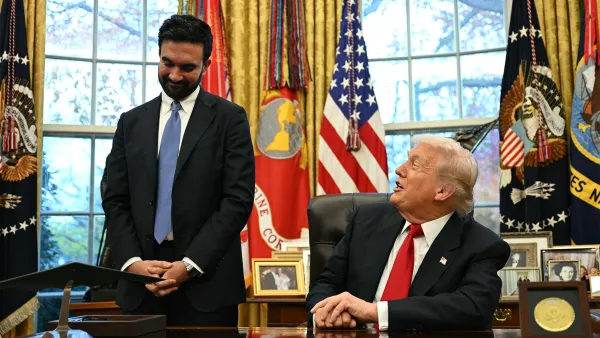DOGE was Inevitable
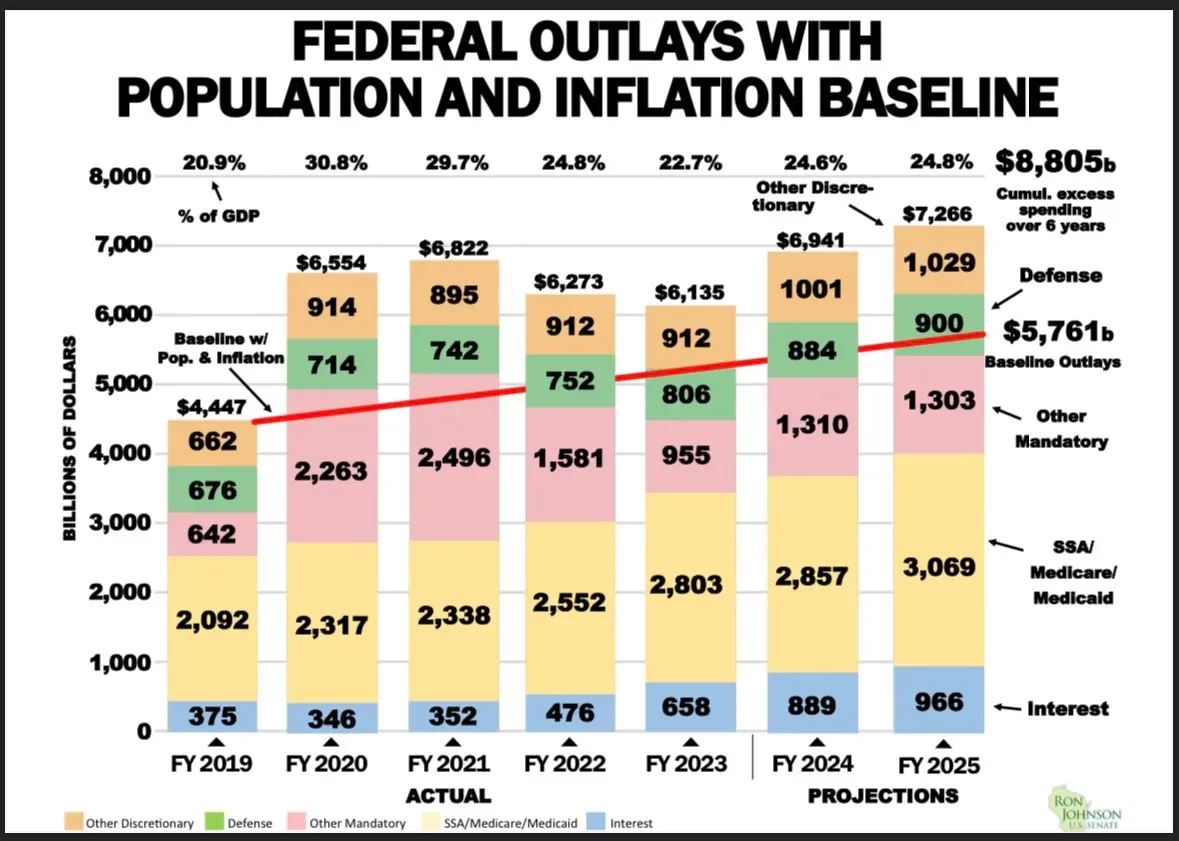
Any time a politician makes a campaign promise, you’ll find varying degrees of deserved skepticism on the part of the media and the public. Over time, as promises are made and never fulfilled, you might even start to tune these promises out, believing they’ll never come to pass.
This was certainly the case when then president-elect Trump announced his intent to allow Elon Musk and Vivek Ramaswamy to head up what he called a Department of Government Efficiency (a.k.a DOGE). Trump wrote in a post that the Department of Government Efficiency, or DOGE, will “become, potentially, ‘The Manhattan Project’ of our time.” He also said the group would, “pave the way” for his administration to “dismantle Government Bureaucracy, slash excess regulations, cut wasteful expenditures, and restructure Federal Agencies.”
“The Manhattan Project,” really? The media doubted the whole idea. NBC News wrote on November 15, 2024: “Democrats and good government groups are skeptical of how much Trump's outside commission run by Elon Musk and Vivek Ramaswamy will be able to do... It won’t actually be a 'department,' like the Department of Education or the Department of Homeland Security.”
Not even three months later, the media is in full meltdown, politicians’ hair is on fire, and protesters are taking to the streets from one end of the country to the other. What happened?
Dire Straits
As America nears its 250th birthday, it enjoys unparalleled hegemony on the global stage and an enviable quality of life at home (just look at the number of people trying to immigrate, albeit illegally). But its finances are a complete mess.
Liberal comedian Bill Maher said this week on his show, “Here's what our system has devolved into: We vote to spend money we don't have, spend it, and then vote whether to pay the bill. And then one party threatens to crash the economy by not paying, so then we vote just enough money to keep the government open for a few months at a time. Reminds me of when I was broke and would put $1 of gas in my car every time I ‘filled’ up.”
America is indeed “broke.” The U.S. debt is too staggering to comprehend. It's $36 trillion—**and grows by $1 trillion every 100 days.**
It’s double what it was in 2015 18 trillion). And the debt-to-GDP ratio is at a critical 124%.
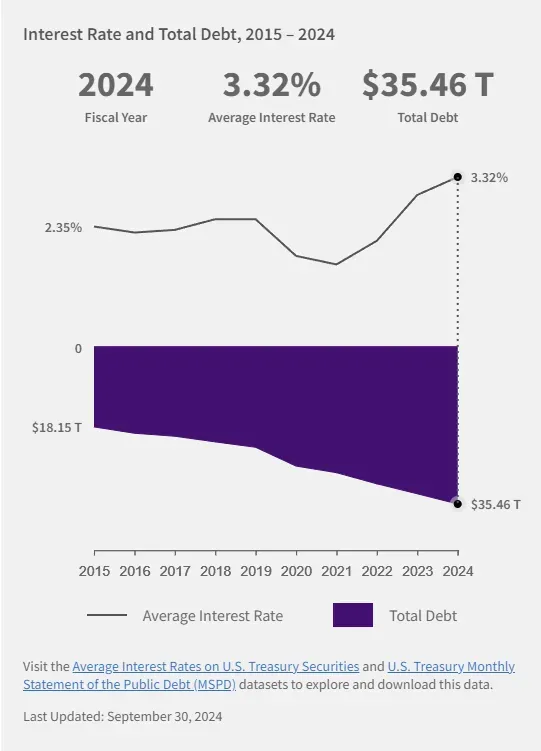
Here’s a way to look at it in scale. The United States has the largest defense budget in the world: over $900 billion. China is the next highest defense spender, at around $296 billion. And yet the U.S. spends more servicing its debt than it spends on defense!
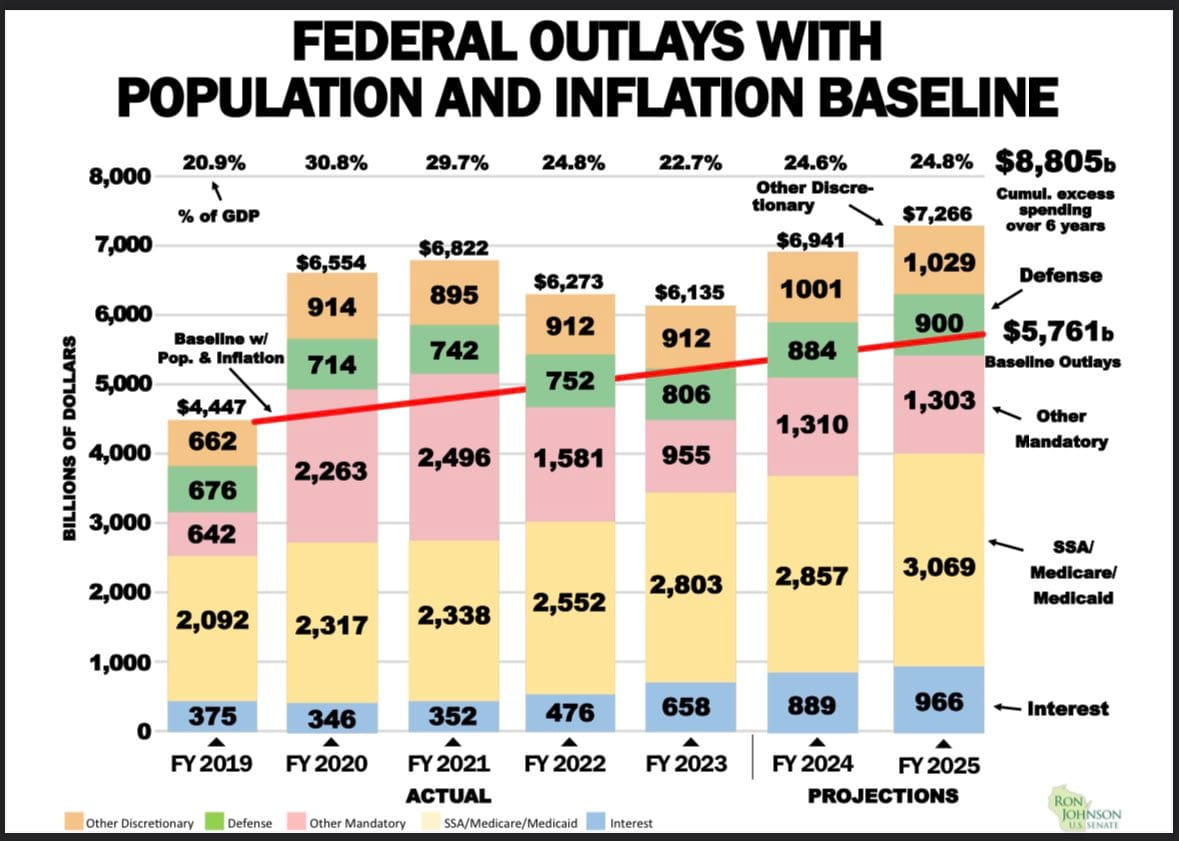
The next chart correlates to the chart above, except it shows how much of the expenses are actually covered by income. The rest is added to the national debt every year.
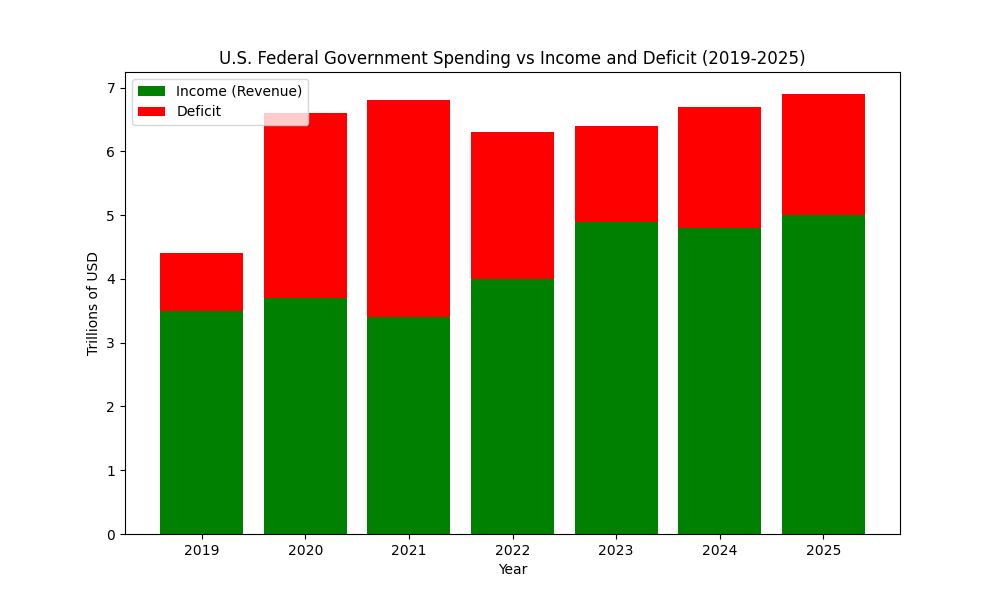
So it’s midnight, and the writing is on the wall of the empire. Even with explosive GDP growth, cutting government, now or later, is unavoidable. As painful as the remedy may be, the prognosis is horrible. Now cue DOGE…
President Obama Actually Created DOGE
(Believe it or not!)
President Obama established the United States Digital Service (USDS) in 2014 to modernize government technology and improve digital services. Trump renamed the United States Digital Service to the United States DOGE Service, which even kept the acronym the same. Not only did repurposing an appropriate existing department allow Trump to ensure there was funding for DOGE without having to fight with Congress: it also ensured its legality.
Here’s something else you might not have known: DOGE is read-only. Despite the rhetoric, Musk has no power to stop government payments or make any changes to the government. His team can view the data in government systems and report on what they see. But they have no ability to make changes.
Here’s a simplified explanation of the way federal funding works:
Federal spending falls into two main categories: mandatory and discretionary. Mandatory spending, which makes up about two-thirds of federal spending, is required by existing laws such as Social Security and Medicare. It doesn't need annual Congressional approval. Discretionary spending, on the other hand, requires annual approval through the Congressional appropriations process and primarily funds defense and various federal agencies. (There are also supplemental appropriations, which address unexpected needs during the fiscal year.)
After Congress appropriates funds and the President signs the bill, the Treasury Department records in its systems the amount that each agency has available to spend. Then when an agency needs to make a payment (e.g., to contractors, grantees, or for operational costs), the agency will submit a request to the Treasury, which verifies available funds and handles the actual transfer of money using various electronic payment systems. This is how nearly 90% of federal payments are being made.
Now that DOGE has (again, read-only) access to the Treasury payment systems, they are able to see where all federal funds are going.
Mandatory payments like Social Security, Medicare, etc. are not a focus of DOGE, which is looking at ways to save on discretionary spending, while President Trump works with Congress to pass laws reducing mandatory spending.
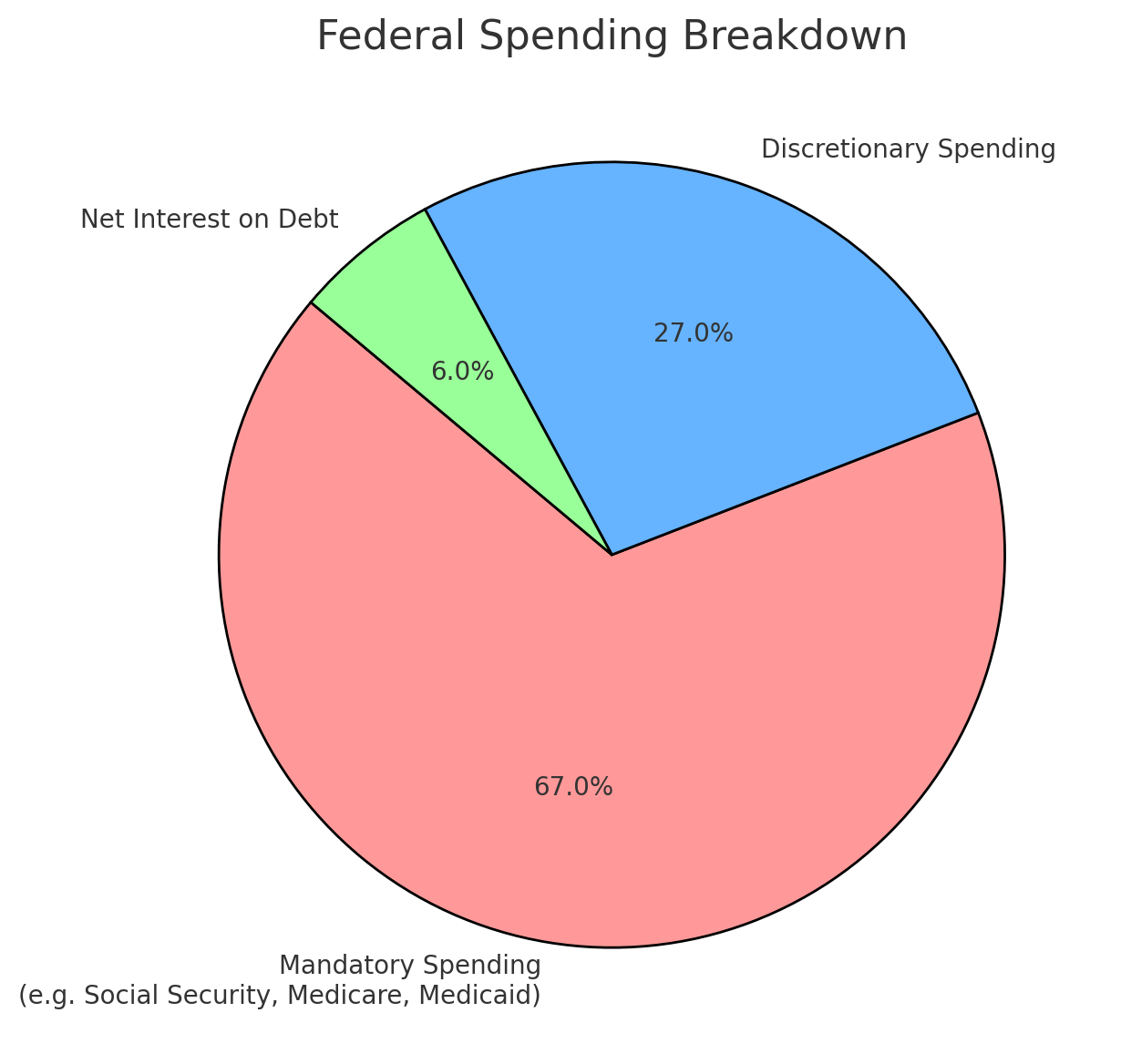
What Has DOGE Found so Far?
The DOGE team took the spending records and put them in an easily searchable database, and the internet went to work.
The findings began to reveal a complex network of billions of U.S. discretionary dollars going to government organizations who then funnel the money to nonprofits and NGOs.
Nonprofits
- Many are flagged as high-taxpayer-funded, meaning that their support is primarily from the government.
- Politicians from both sides of the aisle appear on the boards of nonprofits which receive vast sums from USAID, such as the International Republican Institute and the National Democratic Institute.
- Church organizations have received millions from government organizations seeking to use the church to promote partisan issues and to support illegal immigration. For instance, Christianity Today’s editor-in-chief Russell Moore took money from Bill Kristol's explicitly partisan, anti-Trump organization, Defending Democracy Together, as well as the Rockefeller Foundation, all to develop political church curriculum and promote it through Christianity Today. In addition, Catholic Charities received $1.4 billion to resettle migrants, and the Lutheran Immigration & Refugees got $183 million.
NGOs
- USAID and other government agencies give grants to NGOs for projects that are either at best humorously suspect ($2.3 million for “artisanal and small scale gold mining” in the Amazon), or at worse blatantly progressive ($7.9 million to teach Sri Lankan journalists how to avoid “binary-gendered language”).
- Only 12% of USAID funds go directly to local organizations in the countries where aid is intended. Most of the time it goes to U.S.-based companies that work in developing countries, or international organizations. Of the money that goes to the implementation partner, much of it is allegedly used for “overhead,” meaning that very little (estimates of 10%) actually make it to needs.
The international development career track often follows a predictable path: advanced degrees followed by NGO work implementing projects like sustainable farming, water infrastructure, and microlending in developing regions. Yet six months after wrapping up shop and on to the next grant, the water well might be broken, the farming project stalled, or the crops failed. But the nice houses in the capital, Cessna Caravan flights, tuition for the kids to the fancy schools? Those never end.
Despite its humanitarian-sounding name, USAID is largely bi-partisan white-collar welfare that goes into the pockets of the wealthiest neighborhoods of D.C. and northern Virginia, and advances U.S. foreign policy abroad.
Everyone’s Talking about USAID
The yearly budget of the entire National Intelligence Program is $73.4 billion. Yet the annual budget of USAID is over $40 billion. USAID has operated on a grant database without details available to the public, and administrators of the program have not been forthcoming in answering queries from Congress.
For some time, many have said that the USAID agency (created via executive order by JFK in 1961) is in reality operated less for open-hand humanitarian aid and more for achieving foreign policy objectives in countries around the world. This should be no surprise, because the program was introduced during the Cold War as a way to combat the global rise of communism. The agency was created to take over the overlap operations between the CIA, State Department and International Cooperation Administration (ICA).
The threat of losing USAID money keeps the recipient country or organization aligned with the U.S.’s foreign policy objectives. (For instance, in 2014, then Vice-President Joe Biden threatened to withhold a $1 billion USAID loan to the country of Ukraine if they did not fire their prosecutor general.)
Here are a few USAID fund recipients that DOGE was dismayed to find:
- $27 million to Black Lives Matter through the Tides Foundation
- $52 million to the World Economic Forum (WEF)
- $27 million to the fiscal sponsor of the group controlling George Soros-funded prosecutors (USAID donated more than George Soros himself)
- $38 million to Ben Hu, a high-level researcher at the Wuhan Institute of Virology, who was working on “bat coronavirus emergence” research (later “patient zero” for COVID-19)
Is the Press Actually Free?
Major media organizations receive significant government funding through various channels. Here are some examples:
- Politico: $34.3 million in government contracts for "pro" service subscriptions, including $8.2M last year alone
- Reuters received over $300 million in government contracts
- Received payments from 11 agencies that investigated Musk's businesses
- Reuters later won Pulitzer Prize for “their work on Elon Musk and misconduct at his businesses”
- BBC: Receives £2.6 million (8% of its income) from USAID
- USAID annually spends $268 million supporting thousands of journalists and media outlets across 30 countries
A key player is Internews Network, which has received nearly half a billion dollars from USAID. Led by a former USAID manager, it influences thousands of media outlets globally, particularly in post-Soviet regions—funding and training journalists, establishing media organizations, and playing crucial roles in various color revolutions, including those in Serbia, Georgia, and Ukraine. The organization now works with advertisers across the globe to only advertise with news outlets that do not produce “misinformation.” This is in keeping with USAID’s formal policy goal of having USAID partners do “advertiser outreach” to “redirect funding.”
This raises a fundamental question: Can media outlets receiving government funding truly be considered "independent," or should they be classified as state media? This becomes particularly relevant when examining USAID's role in shaping global narratives aligned with U.S. foreign policy objectives.
The list continues, reading like a progressive’s wishlist:
- $20 million for a new Sesame Street show in Iraq
- $1.5 million for “art for inclusion of people with disabilities”
- $2 million for sex changes and “LGBT activism” in Guatemala
- $6 million to “transform digital spaces to reflect feminist democratic principles”
- $10 million worth of USAID-funded meals which went to an al Qaeda-linked terrorist group
- $25 million for Deloitte to promote “green transportation” in the country of Georgia
- $6 million for tourism in Egypt
- $2.5 million to promote “inclusion” in Vietnam
- $16.8 million for a separate “inclusion” group in Vietnam
- $5 million to EcoHealth Alliance, one of the key NGOs funding bat virus research at the Wuhan lab
- $1.1 million to an Armenian “LGBT group”
- $1.5 million to promote “LGBT advocacy” in Jamaica
- $1.5 million to “rebuild” the Cuban media ecosystem
- $2 million to promote “LGBT equality through entrepreneurship” in Latin America
- $3.9 million for “LGBT causes” in the western Balkans
- $5.5 million for LGBT activism in Uganda
- $6 million for advancing LGBT issues in “priority countries around the world”
- $8.3 million for “USAID Education: Equity and Inclusion”
So after these revelations, what happened? Treasury officials quickly ceased approving USAID expenses, and President Trump fired USAID employees and ordered a review of all NGOs receiving money from the government.
And that’s when the meltdown began.
Will the System Allow Itself to Be Changed?
People ran a headline that read, “Panicked USAID Workers Grapple with Defunding of Humanitarian Efforts: ‘People Will Starve, Babies Will Die.’” Even if the media is not abetting an effort to protect corrupt spending with human shields (and they have financial incentive to do so), this raises a serious question: If the government ceases funding charity, and charity ceases, was it charity at all to begin with? If you’re not a Marxist, State-sponsored charity should be a contradiction in terms. The whole point of “charity” is that it comes from the heart and will of people, not the State.
People have long believed that the government is wasteful, and they have long begrudged sending hard-earned tax dollars to a city that seems prone to misuse it. But the public now sees clear examples of corruption. It’s easy to read a hot take and quite another to be confronted with actual dollar amounts. It is clear what needs to be done to stop the bleeding (drastically cut spending), and the public has an ally in Elon Musk. But will the system allow its own cleansing?
We’ll find out soon enough. Till then, I’ve got an idea for how to turn vast stretches of the Sahara Desert into an experimental ice farming region. I’m looking for investors.



